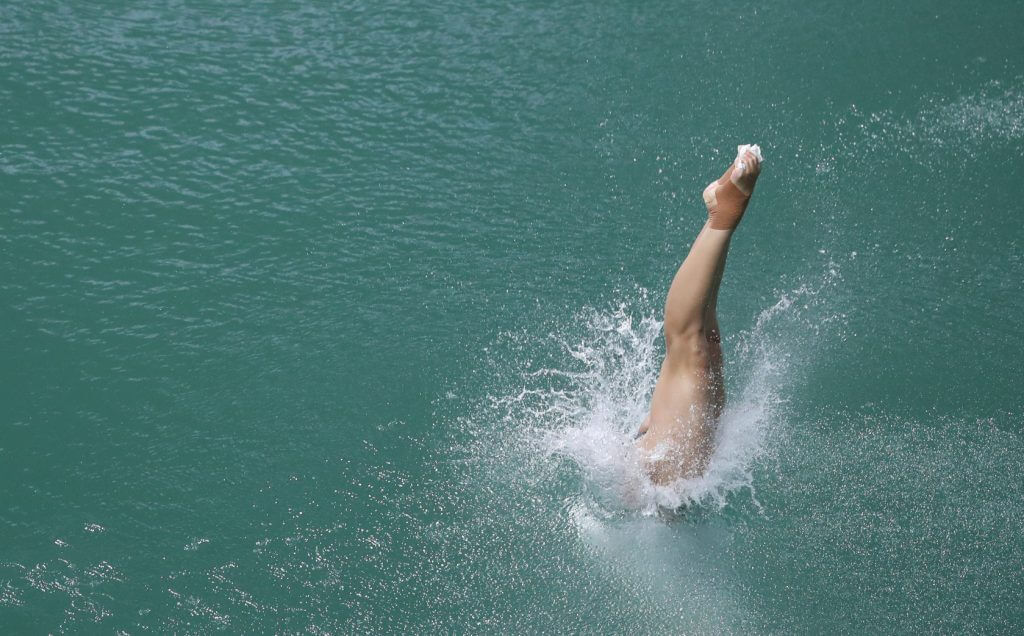What Would The NCAA Look Like Without Diving?

By Matthew Barnard, Swimming World College Intern.
In 2014 Swimming World posed the question “Should diving have a separate NCAA championship?“. Back then almost 72% of people responded that they would like to see a split between the two sports with two separate championships. Nevertheless, almost three years later, according to the NCAA, swimming and diving is still very much one sport.
However this question raises many more. Which schools are assisted most by diving teams? How much does diving really affect final placings? What would NCAA swimming results look like without diving?
Here is a look back to what would have happened in 2016 if swimming and diving were separate sports.
Women
Georgia brought home the National Championship title in 2016 and if diving wasn’t scored it would have been no different. However, California would have jumped ahead of Stanford to take second, with Stanford falling to third.
Nevada, Miami (Ohio), LSU and South Carolina would all have fallen out of the top 30 teams with UCLA falling 10 places to 27th. Wisconsin would see a huge benefit, moving from 21st to 16th.
In the diving championship, Nevada, led by Sharae Zheng, and Stanford, led by Gracia Leydon-Mahoney, would have tied for first (56 points) with UCLA (55 points) only one point behind in third, Minnesota (40 points) and Miami (Ohio) (33 points) would have rounded out the top 5.
Here is what final rankings would have looked like at a women’s swimming championship in 2016 without diving (top 30):
| Place (Change) | School | Points Without Diving |
|---|---|---|
| 1 (-) | Georgia | 400 |
| 2 (↑1) | California | 358 |
| 3 (↓1) | Stanford | 339 |
| 4 (-) | Texas A&M | 302 |
| 5 (-) | Virginia | 264 |
| 6 (-) | USC | 244.5 |
| 7 (↑1) | Louisville | 220 |
| 8 (↓1) | Indiana | 217 |
| 9 (-) | NC State | 155 |
| 10 (-) | Michigan | 150 |
| 11 (-) | Missouri | 127 |
| 12 (-) | Arizona | 120 |
| 13 (-) | Tennessee | 108 |
| 14 (-) | Ohio State | 84 |
| 15 (-) | Texas | 79 |
| 16 (↑5) | Wisconsin | 49 |
| 17 (↑1) | UNC | 48 |
| 18 (↑1) | Florida | 34.5 |
| 19 (↓3) | Minnesota | 30 |
| 20 (↑2) | Kentucky | 29 |
| 21 (↑4) | Virginia Tech | 23 |
| 22 (↑3) | Penn State | 23 |
| 23 (↑5) | Alabama | 20 |
| 24 (↑5) | UMBC | 18 |
| 25 (↓2) | Purdue | 17 |
| 26 (↑7) | Auburn | 14 |
| 27 (↓10) | UCLA | 13 |
| 28 (↑6) | Kansas | 11 |
| 29 (↑5) | Air Force | 11 |
| 30 (↑7) | Denver | 10 |
Men
Texas handily claimed the national title in 2016 and would have done so even if diving wasn’t there. In fact the top six teams would have remained the same.
7th placed Tennessee would fall 5 places to 12th, Minnesota would fall from 20th to 36th, Pittsburg and Miami (both 22nd) would fall out of scoring completely.
Tennessee would have come out on top in a diving championships with the help of Liam Stone and Mauricio Robles scoring 61 points, while Texas would have been close behind with 60 points. Ohio State (40 points), Minnesota (39 points) and Arizona (34 points) would complete the top 5.
Here is what final rankings would have looked like at a men’s swimming championship in 2016 without diving (top 30):
| Place (Change) | School | Points |
|---|---|---|
| 1 (-) | Texas | 481.5 |
| 2 (-) | California | 351 |
| 3 (-) | Florida | 334 |
| 4 (-) | NC State | 314 |
| 5 (-) | Georgia | 237.5 |
| 6 (-) | Alabama | 225 |
| 7( ↑1) | Missouri | 166 |
| 8 ( ↑1) | Indiana | 165.5 |
| 9 ( ↑2) | Louisville | 164.5 |
| 10 ( ↑2) | Michigan | 158 |
| 11 ( ↓1) | Auburn | 151 |
| 12 ( ↓5) | Tennessee | 127 |
| 13 (-) | USC | 98 |
| 14 (-) | Stanford | 96.5 |
| 15 ( ↑2) | South Carolina | 66 |
| 16 (-) | Arizona | 53 |
| 16 ( ↑2) | Wisconsin | 53 |
| 18 ( ↓3) | Ohio State | 51 |
| 19 (-) | Virginia Tech | 44.5 |
| 20 ( ↑1) | Brigham Young | 40 |
| 21 ( ↑3) | Penn | 26 |
| 22 ( ↑4) | Air Force | 16 |
| 23 ( ↑5) | Virginia | 15 |
| 23 ( ↑5) | Cleveland St | 15 |
| 25 ( ↑5) | Oakland | 13 |
| 26 ( ↑7) | George Washington | 11 |
| 26 ( ↑7) | Yale | 11 |
| 28 ( ↑7) | UNLV | 9 |
| 29 ( ↑8) | Princeton | 8 |
| 30 ( ↓5) | Texas A&M | 7 |
All commentaries are the opinion of the author and do not necessarily reflect the views of Swimming World Magazine nor its staff.




No different than Football without Fencing…
Quite an interesting read. Many people discuss the subject but it is interesting to see how it would actually change the stats. Great work, Matt!